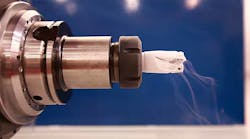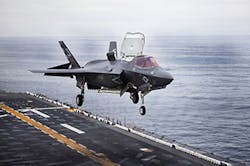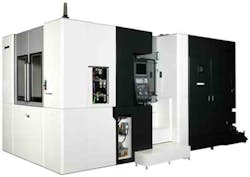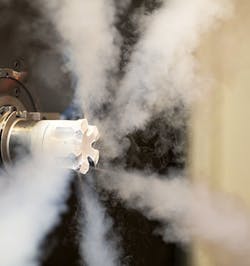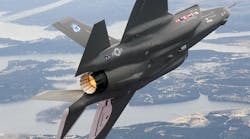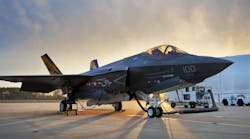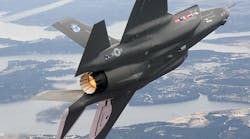The F-35 Lightning II is a marvel of aeronautic engineering, design, and construction, but the development and construction costs have been controversial for over a decade, so much so that the program’s primary contractor, Lockheed Martin, was compelled to commit to U.S. Dept. of Defense cost-cutting goals. Those savings have begun to materialize.
The F-35 Lightning II is a single-engine fighter capable of ground attack, reconnaissance, and air defense missions by the U.S. Air Force, U.S. Navy, U.S. Marine Corps, and the U.K. Royal Air Force. The first of three variants, the F-35B for short takeoff and vertical landing, was introduced last summer by the USMC. The F-35A, for conventional takeoff and landing; will be introduced later this year by the USAF.
The U.S. Navy is scheduled to introduce the third version of the jet, the F-35C for carrier-based operations, in 2018.
At its Dallas development and manufacturing center, Lockheed installed an Okuma MA-60HII horizontal machining center updated with 5ME’s patented cryogenic machining system, to execute roughing and finishing on large-dimension titanium airframe elements for the F-35.
The MA-60II has a work envelope of 1,000x900x1,000 mm (39.37x35.43x39.37 in.), with a 630x630-mm (24.80x24.80 in.) rotary pallet. The machine developer claims it’s reliable for any task from high-volume, steady machining of large-scale parts (e.g., airframes) to long, continuous work on detailed parts (e.g., die/mold applications.)
Cryogenic machining (cutting or turning) directs liquid nitrogen (e.g., -200° C) at the cutting tool and/or workpiece to cool the surface, thereby allowing higher speeds/feeds, and eliminating the need for standard coolants. Okuma and 5ME teamed up last year to demonstrate the effectiveness of cryogenic machining in industrial-scale operations, including faster processing sequences, longer tool life, increased part quality, and reduced environmental impact.
The 5ME process transmits liquid nitrogen at -321°F through the spindle/turret and tool body, just below the cutting edge, not only cooling the surface but increasing throughput, part quality, tool life, and profitability for the highly demanding titanium roughing and finishing process.
Reducing the temperature at the cutting surface helps to achieve faster cutting speeds, which makes liquid nitrogen-based cryogenic machining ideal for tough to machine materials. The system is self-pressurized, so no pumps and other power-consuming assets are needed.
5ME’s patented sub-cooler extracts pressure-generated heat from the system and condenses dual-phase liquid nitrogen (liquid and gas) back to 100% liquid, preventing the formation of gases from downstream heat leaks and pressure drops.
Overall, it’s an environmentally friendly process because it reduces energy consumption for the cutting very hard materials.
Three options for storage include a vacuum container (or “dewar”) for individual machines, micro-bulk vessels for machining cells and central/external storage for large-scale installations.
To ensure that critical components are not exposed to cryogenic temperatures, the feed system uses vacuum-jacketed, insulated lines between the LN2 source and sub-cooler as well as to the spindle.
The integral Cryo Controller allows operators to program the flow rate to match requirements of the application. The cryogenic machining system can be retrofitted easily to almost any OEM spindle, and multiple tool interfaces are available. 5ME’s cryogenic tooling is specifically designed for the system and includes holders, turning and grooving tools, solid carbide mills and drills, indexable mills, drills, and boring tools. The developer will supply asset monitoring and manufacturing efficiency software, for cryogenic machining with any machine tool brand. Application engineering as well as tooling and coolant solutions are also offered.
For Lockheed, test cuts performed on 6AI4V titanium produced a 52% increase in cutting speeds (21 hours with 5ME cryogenics, versus 44 hours with coolant), and maintained an equivalent rate of cutter consumption. Tests using 5ME’s solid carbide cryogenic end mill also improved surface integrity and part quality, and reduced the white layer.
Lockheed estimated that cryogenic technology would help to lower the cost of large titanium parts by 30%.
“The tests we conducted with Lockheed demonstrate the true business advantages of using cryogenic machining for tough-to-cut materials, such as titanium,” according to Pete Tecos, 5ME’s exec. vice president, marketing and product strategy. “This has a significant impact on cost savings for initiatives like the F-35 program, not only in increased cutting speeds, but also through lower energy consumption, improved worker safety, and the elimination of the infrastructure and disposal required with flood coolants.”
